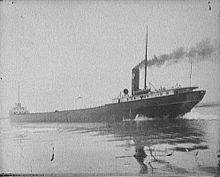Great Lakes Ship
Great Lakes ships , including large-Lakes cruise ships ( english Great Lakes freighter , Lake freighter , laker or Lake boats ) are ships exclusively or primarily on the Great Lakes are used for transportation of bulk cargoes.
The group of Great Lakes Ships forms a separate type of ship in the broader sense, but not a homogeneous type of ship . A common feature of the ships is the bulk transport on the Great Lakes and the operation by American and Canadian shipping companies. The latter is due to the Jones Act , which excludes ships flying foreign flags from cabotage .
details
Within this commonality, numerous groups of different ships can be distinguished historically as well as based on their use or size.
Although there were ships long before that were tailored to the special requirements of the Great Lakes voyage (for example, special types of sailing ships that were used to transport sawn timber, or the backs of whales ), a separate architectural style emerged from around the end of the 19th century the bulk carriers known as Laker . The traditional Great Lakes ships are relatively long and narrow, have a deckhouse with bridge superstructures at the front, a relatively long middle cargo hold and a second, flatter superstructure above the engine plant located very aft. In the last few decades, however, more and more ships with the same type of construction, which is also prevalent in seagoing vessels, with an engine system located very aft and a deckhouse with bridge superstructures arranged above it, have been brought into service. The external appearance of today's newbuildings is therefore similar to that of normal bulk carriers.
The beginning of the equipment with another characteristic of a large part of the ships discussed, the self-unloading devices, is regularly equated with the conversion of the 65-meter-long wooden ship Hennepin to a self-unloader in 1902. Soon thereafter, further and larger conversions and new buildings followed. With the construction of the Wyandotte, 1908 marked the first new construction of a self-unloader designed for the Great Lakes voyage. In the years between 1920 and 1960 the proportion of self-unloaders increased steadily, and since 1965 ships of this type have been built almost exclusively. The still existing ships without self-unloading devices are called straight decker (German: Geraddecker ) and mostly belong to Canadian shipping companies.
Another distinction is that between real Laker and so-called Salties (German about: Salzies ).
A notable factor is the noticeably long service life achieved by the vast majority of the Great Lakes fleet. The reason for this lies in its operation in a freshwater area, which exposes the hulls to much less of the corrosion common in saltwater. If normal ocean-going vessels are scrapped after an average of 25 to 30 years, the average lifespan of the Laker is decades longer.
In addition to the ships originally built for operation on the Great Lakes, there are numerous seagoing ships that have been adapted to the conditions of this shipping area through modifications, such as extensions and other details.
Dimensioning
Depending on the intended sailing area, there are different sizes of Laker. A particularly well-known measure is the Seawaymax , which can just barely pass the locks of the St. Lawrence Seaway, the connection between the Great Lakes and the Atlantic. Ships of this type are 226 m long, 24 m wide, have a draft of 7.9 m and a maximum height above the water surface of 35.5 m. Seawaymax ships can carry around 28,500 tons of cargo. Seawaymax ships, which are also seaworthy, ergo can also serve seaports outside the Great Lakes, are called Salties . Salties also include a number of push convoys , mostly articulated tug barges , that connect ports on the Great Lakes with American east coast ports.
In addition, there are larger ( real ) Laker whose dimensions limit their use to the Great Lakes. These larger ships are up to 308 meters long and have load capacities of up to 72,000 tons.
literature
- Dudzus, Alfred; Köpcke, Alfred: The big book of ship types . Licensed edition by transpress, Berlin edition. Weltbild-Verlag, Augsburg 1995, ISBN 3-89350-831-7 .


